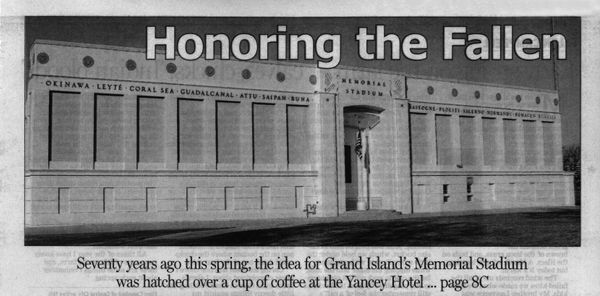MARCH 8, 2018
Grand Island Memorial Stadium

A Brief History of Grand Island Public Schools: Memorial Stadium
Source: Grand Island Nebraska, April 4, 1957 Chapter IV pages 36-38; Earle W. Wiltse
Memorial Stadium
At the close of World War II, the community seeking a suitable memorial for veterans of World War II. Arch Jarrell, Editor of the Grand Island Daily Independent and Member of the Board of Education has prepared the following story about the Memorial Stadium.
The history of Grand Island’s Memorial Stadium dates from the spring of 1945, when a group of men met informally for a coffee session.
A few weeks previously, the Board of Education had purchased the old Baptist College property, in the northwestern part of the city, and had announced its intention of building a new athletic field on that site to replace Ryder Park, which had been used for many years.
This group agreed, between sips of coffee, that it would be a fine thing to have a campaign for funds to build a stadium as a war memorial. George Winters, then general manager of the Daily Independent, pledged the newspaper to a $5,000 contribution. The Lions Club promptly came across with $1,000. This made $7,000 before the drive started.
With this nucleus and delegation, headed by District Judge E.G. Kroger as spokesman, appeared before the Grand Island Board of Education on April 7, 1945 and asked permission to conduct such a campaign. The Board promptly agreed.
The next step was to find a sponsor for the campaign. At the meeting on April 11, the American Legion agreed to take on that responsibility. A campaign committee was appointed by Jess Blodgett, Legion Commander. With G. Lawrence Gorman as Chair, the committee included C.E. Grundy, John McCarthy, H.P. Zieg, Arch W. Jarrell, and George J. Armstrong. Armstrong was named Treasurer.
The Campaign for funds began in May, 1945, and continued throughout the year. At the outset the Liederkranz matched the Independent’s $5,000, and they remained the largest contributions made during the campaign, although there were sixteen other contributions of $1,000 or more.
At the end of 1945, the campaign stood at more than $77,000, including the Ryder Park payment. The following year, at a slower pace but nonetheless steadily, the campaign continued, and by the end of 1946 the committee was getting close to its goal. It was well past $90,000 by the end of that year.
In 1947, the American Legion agreed to put on a final campaign to bring the fund over the $100,000 mark and Bayard H. Paine Jr., a recently returned World War II Veteran, headed the committee. That committee completed the job, and the finals showed more than $102,000, all of it by subscription except the $17,800 paid for Ryder Park.
The stadium was constructed in 1947, and dedicated September 16 of that year. The first game, on September 19, was played with Norfolk, and the Islanders won 45-0. A named flashed onto the football horizon in that game. That was Bob Reynolds, whose wizardry had much to do with the overwhelming victory.
Architect E.G. Schaumberg, of Lincoln, Nebraska designed the structure. It includes at East Stadium, seating 1,950 people, and a West Stadium for 1,080 people. The East Stadium contains dressing rooms, tickets booths, public toilet facilities, a snack counter and a memorial niche for the names of 131 veterans of World War I and II. A quarter mile cinder track and a seven foot chain link fence complete the modern stadium facility. Portable bleachers increase the seating capacity to 5,000. This capacity is required for several events each year. The total cost of the Memorial Stadium, with cinder track and fence, was $104,312. It represents a suitable tribute to World War veterans and is considered by many to be Nebraska’s finest High School Football Stadium.











